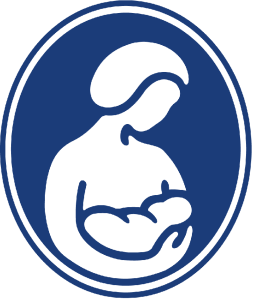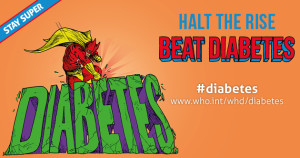WABA / LLLI
Joint Statement
in celebration of
World Health Day
7 April 2016
The 2016 World Health Day (WHD) theme is “Beat Diabetes.” According to the World Health Organisation (WHO)1:
- In 2014, nine percent of adults 18 years and older had diabetes.
- In 2012, diabetes was the direct cause of an estimated 1.5 million deaths, with more than 80% of diabetes deaths occurring in low and middle-income countries. WHO projects that diabetes will be the 7th leading cause of death worldwide in 2030.

What is Diabetes?
Diabetes Mellitus is a chronic disease involving how sugar is processed and used by the body. Sugar provides the energy that cells in the body need to function. Insulin, a hormone produced by the pancreas, regulates how much sugar is in the blood. People with diabetes are prone to having high blood sugar, which can cause damage to many organs in the body. Diabetes occurs when either the pancreas does not produce enough insulin, or when the body can’t effectively use the insulin it produces.
Types of Diabetes
There are two main forms of diabetes:
- Type 1: Type 1 diabetics cannot make insulin and so they need insulin injections to live.
- Type 2: Type 2 diabetics can produce insulin, but don’t make enough or can’t use it properly. Insulin injections are sometimes also required for type 2 diabetics. Type 2 diabetes is more common than type 1, and is often related to obesity and sedentary lifestyles.
A third type of diabetes, gestational diabetes, occurs during pregnancy. Blood sugar levels are higher than normal, but less than those characteristic of other forms of diabetes. Gestational diabetes can lead to complications during pregnancy and delivery, and can increase mother’s future risk of type 2 diabetes.
Diabetes can lead to heart attacks, strokes, nerve damage, kidney failure, blindness, impotence, and infections. Because of several of those complications, amputations of the lower extremities are often required.
What about Breastfeeding?
Breastfeeding protects mothers and infants from a wide range of short and long term illnesses, including a likely risk reduction for both types 1 and 2 diabetes2,3,4.
Breastfeeding, Mothers, and Diabetes
Mothers who breastfeed their children lower their risk for diabetes, and, as is often seen in breastfeeding research, the protection is dose-dependent. The total number of months a mother breastfeeds all of her children, the more protection from diabetes she is likely to receive5.
Gestational Diabetes
There is good evidence that mothers with gestational diabetes who breastfeed have a lower risk of developing type 2 diabetes later on. A recent study followed about a thousand women diagnosed with gestational diabetes at 35 weeks or later in singleton pregnancies. The highest risk for these women to develop type 2 diabetes was associated with mostly formula feeding, followed by mixed feeding5. The risk was lowest among women who exclusively breastfed.
Mothers who breastfed the longest (greater than 10 months) had the lowest risk among the women who breastfed after gestational diabetes. The study concluded, “Higher lactation intensity and longer duration were independently associated with lower 2-year incidences of Diabetes Mellitus (DM) after gestational diabetes mellitus (GDM) pregnancy. Lactation may prevent DM after GDM delivery.”5
Type 2 Diabetes
Breastfeeding is associated with a decreased risk for mothers developing type 2 diabetes. Studies include:
- A study looked at 140,000 postmenopausal women and found that a lifetime history of more than 12 months of breastfeeding was related to lower risk of diabetes and other related cardiovascular diseases6.
- A study looked at over 150,000 women and found that a longer duration of lactation reduced the risk of type 2 diabetes, and that each additional year of breastfeeding decreased the risk by 15%7.
Breastfeeding, Children, and Diabetes
Children who are breastfed also appear to be at reduced risk for diabetes.
- The 2013 “Long-term effects of breastfeeding:A systematic review”
World Health Organisation publication concluded: “The evidence suggests that breastfeeding may have a protective effect against type 2 diabetes, particularly among adolescents.”8
Type 1 Diabetes
The relationship between breastfeeding and protection against type 1 diabetes is not as clear as with the other forms of diabetes. Studies have yielded mixed results, which may reflect study design, such as how breastfeeding was defined, relying on recall of feeding from prior years, and other factors. WHO states, “There is no known way to prevent type 1 diabetes.”9

Explaining the Link between Breastfeeding and Lowered Risk of Diabetes
Breastfeeding is the biological norm—humans are built to expect breastfeeding as a normal course of events after birth and delivery. How might breastfeeding protect against diabetes?
While the actual mechanism for such protection is not fully understood, researchers are beginning to understand more about how it might work:
- Authors noted that “lactation improves glucose metabolism,” which may help explain the correlation between breastfeeding and lowered risk of diabetes after GDM5.
- Being overweight and obese are major factors in triggering type 2 diabetes. There is growing evidence that breastfeeding protects against these two factors, which could, in turn, lower diabetes risks4.
- Breastmilk contains long-chain polyunsaturated fatty acids, which may protect against insulin-resistance and type 2 diabetes10.
- Formula-fed infants have higher concentrations of insulin, which may overwhelm the infant’s ability to process the insulin and may contribute to type 2 diabetes10.
As diabetes rates rise worldwide, as well as death rates associated with it, breastfeeding’s potential effect on reducing this epidemic should not be underestimated. As with any study of breastfeeding’s effect on a specific illness or condition, the benefits of breastfeeding—as well as the risks of not breastfeeding—extend beyond just the one studied condition. Breastfeeding, as the biological standard, helps infants and children begin life as nature intended.
For more information, please contact:
Key Writer: Melissa Clark Vickers WABA Secretariat: Chuah Pei Ching
LLL Leader Health & Information Coordinator
References:
- http://www.who.int/
mediacentre/factsheets/fs312/ en/ - Long-term consequences of breastfeeding on cholesterol, obesity, systolic blood pressure and type 2 diabetes: a systematic review and meta-analysis. Horta BL, Loret de Mola C, Victora CG. Acta Paediatr. 2015 Dec; 104(467): 30-7.
- Breastfeeding and the maternal risk of type 2 diabetes: a systematic review and dose-response meta-analysis of cohort studies. Aune D, Norat T, Romundstad P, and Vatten LJ. Nutr Metab Cardiovasc Dis. 2014 Feb; 24(2): 107-15.
- Breastfeeding in the 21st century: epidemiology, mechanisms, and lifelong effect. Victora CG, Bahl R, Barros AJ, et al. Lancet. 2016 Jan 30; 387(10017):475-490.
- Lactation and progression to type 2 diabetes mellitus after gestational diabetes mellitus: A Prospective Cohort Study. Gunderson EP, Hurston SR, Ning X, et al. For the Study of women, infant feeding and type 2 Diabetes after GDM pregnancy investigators. Ann Intern Med. 2015 Dec 15; 163(12):889-98.
- Duration of lactation and risk factors for maternal cardiovascular disease. Schwarz EB, Ray RM, Stuebe AM, et al. Obstet Gynecol. 2009 May; 113(5): 974–982.
- Duration of lactation and incidence of type 2 diabetes. Stuebe AM, Rich-Edwards JW, Willett WC, Manson JE, Michels KB. JAMA. 2005 Nov 23; 294(20):2601-10.
- Long-term effects of breastfeeding: A systematic review. Horta BL, Victora CG. World Health Organisation, 2013.
- http://www.who.int/features/
qa/65/en/ - Long-term effects of breastfeeding: A systematic review. Horta BL, Victora CG. World Health Organisation, 2013.


